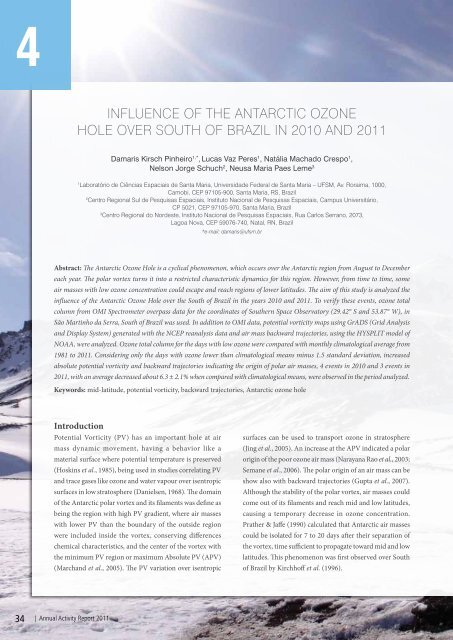1 - Instituto de Biologia da UFRJ
1 - Instituto de Biologia da UFRJ
1 - Instituto de Biologia da UFRJ
You also want an ePaper? Increase the reach of your titles
YUMPU automatically turns print PDFs into web optimized ePapers that Google loves.
4<br />
INFLUENCE OF THE ANTARCTIC OZONE<br />
HOLE OVER SOUTH OF BRAZIL IN 2010 AND 2011<br />
Damaris Kirsch Pinheiro 1,* , Lucas Vaz Peres 1 , Natália Machado Crespo 1 ,<br />
Nelson Jorge Schuch 2 , Neusa Maria Paes Leme 3<br />
1<br />
Laboratório <strong>de</strong> Ciências Espaciais <strong>de</strong> Santa Maria, Universi<strong>da</strong><strong>de</strong> Fe<strong>de</strong>ral <strong>de</strong> Santa Maria – UFSM, Av. Roraima, 1000,<br />
Camobi, CEP 97105-900, Santa Maria, RS, Brazil<br />
2<br />
Centro Regional Sul <strong>de</strong> Pesquisas Espaciais, <strong>Instituto</strong> Nacional <strong>de</strong> Pesquisas Espaciais, Campus Universitário,<br />
CP 5021, CEP 97105-970, Santa Maria, Brazil<br />
3<br />
Centro Regional do Nor<strong>de</strong>ste, <strong>Instituto</strong> Nacional <strong>de</strong> Pesquisas Espaciais, Rua Carlos Serrano, 2073,<br />
Lagoa Nova, CEP 59076-740, Natal, RN, Brazil<br />
*e-mail: <strong>da</strong>maris@ufsm.br<br />
Abstract: The Antarctic Ozone Hole is a cyclical phenomenon, which occurs over the Antarctic region from August to December<br />
each year. The polar vortex turns it into a restricted characteristic dynamics for this region. However, from time to time, some<br />
air masses with low ozone concentration could escape and reach regions of lower latitu<strong>de</strong>s. The aim of this study is analyzed the<br />
influence of the Antarctic Ozone Hole over the South of Brazil in the years 2010 and 2011. To verify these events, ozone total<br />
column from OMI Spectrometer overpass <strong>da</strong>ta for the coordinates of Southern Space Observatory (29.42° S and 53.87° W), in<br />
São Martinho <strong>da</strong> Serra, South of Brazil was used. In addition to OMI <strong>da</strong>ta, potential vorticity maps using GrADS (Grid Analysis<br />
and Display System) generated with the NCEP reanalysis <strong>da</strong>ta and air mass backward trajectories, using the HYSPLIT mo<strong>de</strong>l of<br />
NOAA, were analyzed. Ozone total column for the <strong>da</strong>ys with low ozone were compared with monthly climatological average from<br />
1981 to 2011. Consi<strong>de</strong>ring only the <strong>da</strong>ys with ozone lower than climatological means minus 1.5 stan<strong>da</strong>rd <strong>de</strong>viation, increased<br />
absolute potential vorticity and backward trajectories indicating the origin of polar air masses, 4 events in 2010 and 3 events in<br />
2011, with an average <strong>de</strong>creased about 6.3 ± 2.1% when compared with climatological means, were observed in the period analyzed.<br />
Keywords: mid-latitu<strong>de</strong>, potential vorticity, backward trajectories, Antarctic ozone hole<br />
Introduction<br />
Potential Vorticity (PV) has an important hole at air<br />
mass dynamic movement, having a behavior like a<br />
material surface where potential temperature is preserved<br />
(Hoskins et al., 1985), being used in studies correlating PV<br />
and trace gases like ozone and water vapour over isentropic<br />
surfaces in low stratosphere (Danielsen, 1968). The domain<br />
of the Antarctic polar vortex and its filaments was <strong>de</strong>fine as<br />
being the region with high PV gradient, where air masses<br />
with lower PV than the boun<strong>da</strong>ry of the outsi<strong>de</strong> region<br />
were inclu<strong>de</strong>d insi<strong>de</strong> the vortex, conserving differences<br />
chemical characteristics, and the center of the vortex with<br />
the minimum PV region or maximum Absolute PV (APV)<br />
(Marchand et al., 2005). The PV variation over isentropic<br />
surfaces can be used to transport ozone in stratosphere<br />
(Jing et al., 2005). An increase at the APV indicated a polar<br />
origin of the poor ozone air mass (Narayana Rao et al., 2003;<br />
Semane et al., 2006). The polar origin of an air mass can be<br />
show also with backward trajectories (Gupta et al., 2007).<br />
Although the stability of the polar vortex, air masses could<br />
come out of its filaments and reach mid and low latitu<strong>de</strong>s,<br />
causing a temporary <strong>de</strong>crease in ozone concentration.<br />
Prather & Jaffe (1990) calculated that Antarctic air masses<br />
could be isolated for 7 to 20 <strong>da</strong>ys after their separation of<br />
the vortex, time sufficient to propagate toward mid and low<br />
latitu<strong>de</strong>s. This phenomenon was first observed over South<br />
of Brazil by Kirchhoff et al. (1996).<br />
34 | Annual Activity Report 2011

















